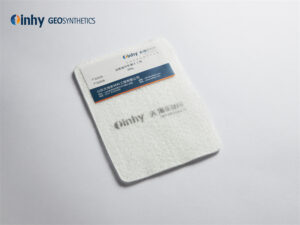What is pp geotextile?
PP geotextile, full name Polypropylene Geotextile, is a geotechnical material used in civil engineering and environmental engineering. Different from PP geomembrane, PP geotextile is a textile material, usually made of polypropylene as raw material, and is used in various civil engineering projects. Its main functions are filtration, isolation, reinforcement and protection.
Some main functions and uses of PP geotextile:
Filtration: PP geotextile has an open fiber structure that allows water to flow through while blocking soil particles and other particulate matter from passing through. This filtration helps prevent soil erosion and protect geostructures.
Isolation: PP geotextile can be used to isolate different soil layers to prevent hybridization or mutual influence of different soil layers. This is useful in soil stabilization, road base and railway works.
Reinforcement: PP geotextile can be used to enhance the mechanical strength of soil and improve its load-bearing capacity. It is commonly used in civil engineering for soil reinforcement, road and railway embankments, etc.
Anti-seepage: In some applications, PP geotextile can be used as an auxiliary anti-seepage layer to reduce water penetration.
Protection: PP geotextiles can be used to protect substructures from soil erosion, water erosion and physical wear and tear. It can be used in projects such as river banks, shorelines, reservoirs and ponds.
Environmental Engineering: PP geotextile is also used in environmental engineering such as soil pollution cleanup, waste disposal and environmental remediation. It can be used to construct landfills and soil covers.
PP geotextiles are usually available in different specifications and quality levels to meet the requirements of various engineering projects. It is a versatile geomaterial that helps improve the sustainability of civil engineering projects, reduce environmental impact, and increase the stability and durability of infrastructure.
Specifications of pp geotextile
The specifications of PP geotextiles can vary based on specific project and application needs, but here are some common specifications and characteristics for your reference:
Gram weight (weight): The gram weight of PP geotextile is usually expressed in grams per square meter (g/m²) or ounces per square yard (oz/yd²). Different engineering projects require geotextiles with different weights. The higher the grammage, the thicker and more durable the geotextile is usually.
Aperture size: The aperture size of PP geotextile refers to the opening size of the material, usually in millimeters (mm). The size of the pores affects the filtration and drainage capabilities of the geotextile.
Tensile Strength: The tensile strength of geotextiles is usually expressed in Newtons (N) or pounds force (lbs), which is a measure of the material’s ability to resist tearing and stretching.
Thickness: The thickness of geotextile is usually measured in millimeters (mm), which affects its mechanical properties and isolation function.
Color: PP geotextile is usually available in black or white, but other colors are also available depending on the needs of a specific project.
Width: Geotextiles are supplied in rolls and their width can vary from 2 meters (6.6 feet) to 7 meters (23 feet). The specific width is usually customized based on project needs.
UV stability: Some PP geotextiles are UV stable to resist the effects of ultraviolet radiation and extend their service life.
Environmentally friendly properties: Some PP geotextiles are environmentally friendly materials, do not contain harmful substances, and are suitable for environmentally friendly projects.
Water filtration performance: The water filtration performance of geotextile depends on the pore size and fabric properties, which is very important for drainage and preventing soil erosion.

pp geotextile price
The price of PP geotextiles varies depending on a variety of factors, including specifications, quality, suppliers, geographical location, and market demand. Here are some general price guidelines, but please note that these prices may vary in different regions and over time:
Specifications and Quality: The price of PP geotextile is usually related to its weight, thickness, tensile strength and other performance characteristics. Heavier, thicker, stronger geotextiles generally cost more because they are generally more durable and suitable for more demanding engineering needs.
Suppliers and brands: Different suppliers and brands of PP geotextile may have different prices. Well-known brands often offer higher prices, but also offer higher quality and performance guarantees.
Geography: Market prices may differ in different regions. Some places may have more suppliers and competition, lowering prices, while other places may have fewer supplies and relatively higher prices.
Market demand: Changes in market demand can also affect prices. When demand is high, prices may rise; when demand is low, prices may fall.
Quantity: Buying large quantities of PP geotextiles can usually result in more competitive prices, as suppliers may offer wholesale discounts.
Special Requirements: If the project requires special features, such as UV stability, environmental certification, or special colors, this may affect the price.
In order to obtain accurate pricing information, your best bet is to contact your local geotextile supplier with the specific requirements of your project to obtain a quote.
Different suppliers may provide different price quotes, so it is wise to compare prices and product features from different suppliers to ensure you are getting the best price and quality PP geotextile for your project needs.
At the same time, it is also necessary to ensure that the quality and specifications of the geotextile meet the requirements of the project to ensure the successful completion of the project.
Author
-

Founded in 2002, Tinhy's team focuses on the manufacturing, marketing, installation, application and research and development of geosynthetic materials.
View all posts




